John Hurrell – 26 January, 2017
How these items inter-relate generates much of the appeal for g. bridle fans, though a speculative narrative that cohesively pulls the exhibits together is not essential, nor are the semiotic dynamics of the enclosing architecture. Each individual piece might hum - in isolation - a different tune from those of its neighbours.
This exhibition is about the power of the enigmatic, puzzling items that thrill. We wonder how does strangeness surface, what makes us stop and look twice at certain objects or images; why are some objects that we come across utterly memorable but yet are not initially attached to any overt narrative. They are not fetishistic (and ‘living’) nor are they uncanny. For some reason the contrived in g. bridle’s hands (his recycled, recombined components) becomes ‘natural’, as if predestined. It is not sense that we discover but some way of mentally connecting assorted particulars that are normally spatially well differentiated.
As is well known now with all his exhibitions, g. bridle here features selections from his collection of photographs and modified found objects called the Retreat - to construct for Bowerbank Ninow a carefully devised installation. Like its next door neighbour, Michael Lett, the space is unusual as a setting, with its floor mosaics, exposed brick ‘beams’ and cut-into wall panels: a terrific environs to display six subtly peculiar items, each deserving of close prolonged scrutiny.
How these items inter-relate generates much of the appeal for g. bridle fans, though a speculative narrative that cohesively pulls the exhibits together is not essential, nor are the semiotic dynamics of the enclosing architecture. Each individual piece might hum - in isolation - a different tune from those of its neighbours.
bridle clearly loves language, as his extraordinarily resonant (and slightly ominous) title shows. He challenges you into imaginatively linking up the seemingly disparate elements.
On entering the gallery space the first thing you notice is a huge lump of immobile concrete positioned in the middle of the polished aggregate floor. Set into a chipped out niche at its top is an old, paint-flaked, porcelain elephant. Much smaller than the hulking stone-peppered cement, it carries a grimy dusty ashtray on its back. The weighty concrete chunk provides a platform for the escaping ascending gaseous residues of the burnt tobacco.
Not immediately in sight, but around the corner in the office, is a photo (enlarged from movie film) of what could be a cigarette end, glowing like copper on a blurry moss-covered rock. It’s been seen in Auckland before, in Glovebox, this work - understood perhaps as something else. Now it is in a new context.
Back in the main gallery we notice a black cigarette holder that is curly: uncharacteristically bent into a spiral. It is part of a long bundle of wooden and bone objects (a shooting stick, a wobbly elongated glass pipette, a pair of tapered bone-lined tongs: all bound together in twine) jammed into a diagonal hole cut through the main protruding corner of the room. The intersection of two walls holds the clenched cluster tightly in position, so that the two ends project out into space. A bundle as a piercing weapon.
Penetration and carnality - it might be argued - are another consistent sub-theme throughout. Perhaps they link to the fires of smouldering cigarettes?
You can’t really ignore the sexual references. Things are hinted at. The elephant has rigid sharpened tusks while its trunk is soft, wrinkled and waving. On the wall behind it is an elegant, cast bronze, coat hook - featuring a couple of curved erect penises. On the other side of the gallery the two glans face an arcing jet of rising and descending water. Blown up from a small negative, the background blue sky is grainy and the water grey, as if spurting not water but mercury. Mercury globules as spray, arching in mid air.
Back near the gallery entrance is another third photograph, that of a bees nest attached to the roof of a cave. The subdued hive looks like a cluster of suspended dark sacs, swinging like bull’s testicles. bridle‘s use of a thick black frame is clever. The heaviness makes the image more masculine, accentuating the bodily references.
There is a strange zigzagging conceptual thread linking bridle‘s chosen assortment of meditative artefacts picked out of his collection archives. Two themes interwoven; but not in a heavy-handed way. Fire and male desire - according to one person’s interpretation. Delicate and allusively intricate.
John Hurrell
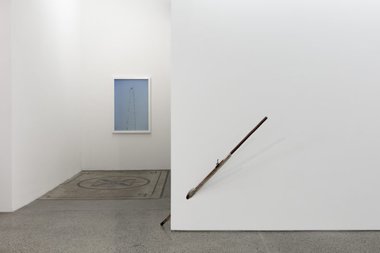
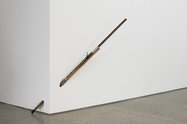

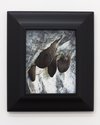
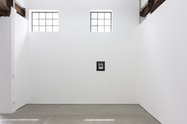
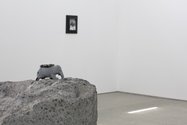

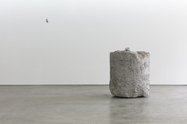

 Two Rooms presents a program of residencies and projects
Two Rooms presents a program of residencies and projects Advertising in this column
Advertising in this column



This Discussion has 0 comments.
Comment
Participate
Register to Participate.
Sign in
Sign in to an existing account.